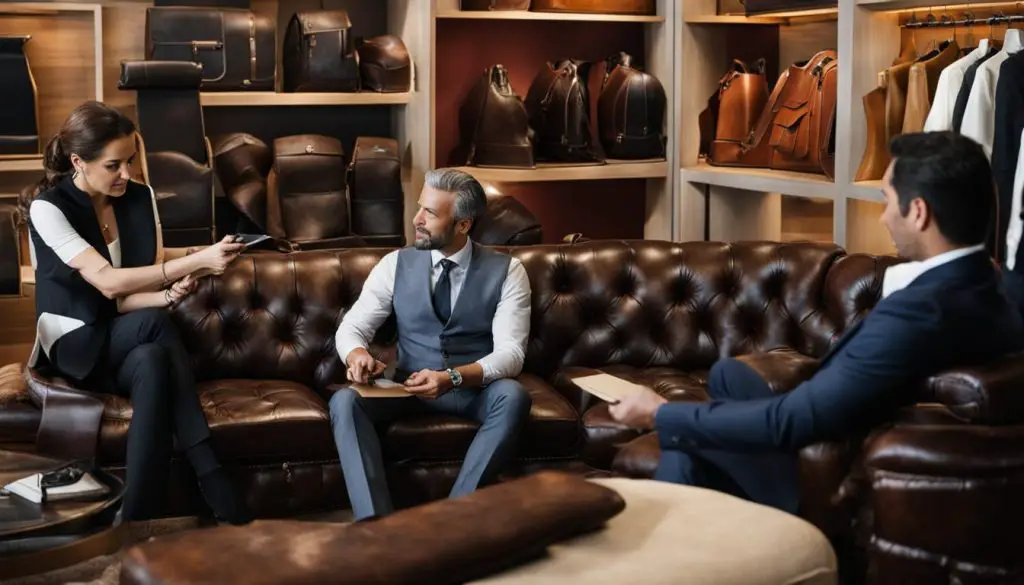If you have a peeling leather couch, it’s crucial to understand the underlying cause and find the most effective solutions for restoration. Real leather doesn’t peel, except for cases where the urethane finish is damaged. Peeling is often a sign of fake leather with a polyurethane coating that has begun to delaminate.
Bonded leather, a composite material made of ground scrap leather and polyurethane skin, is prone to peeling. Unfortunately, no product can completely prevent or protect against peeling. This article aims to provide you with different options to explore to help you fix a peeling leather couch and discuss the importance of investing in a high-quality piece of furniture.
Key Takeaways:
- Peeling leather couches are often a result of fake leather with a damaged polyurethane coating.
- Bonded leather, a composite material, is prone to peeling and delamination.
- There are different options for fixing a peeling leather couch, but they may not provide a long-term solution.
- Investing in a high-quality piece of furniture, such as one made of full-grain leather, is recommended for durability and longevity.
- Understanding the limitations of bonded leather and taking proper care of a leather couch is essential for maintaining its quality and appearance.
Understanding Bonded and Faux Leather: What You Need to Know
When it comes to leather alternatives, it’s crucial to understand the differences between bonded leather and faux leather. This knowledge can help you make an informed decision when choosing furniture or other products made from these materials.
Bonded Leather
Bonded leather, blended or reconstituted leather, is created by combining ground scrap leather with a polyurethane coating. This composite material is more affordable than genuine leather but is not as durable. The polyurethane coating, which gives bonded leather its smooth and glossy appearance, is prone to peeling and delamination over time. As a result, bonded leather furniture may require more frequent repair and replacement compared to genuine leather.
Faux Leather
Faux leather, on the other hand, is a completely synthetic material. It is typically made from rayon or polyester fabric coated with a polyurethane skin. Faux leather offers a similar look and feel to genuine leather but without the use of any animal products. Unlike bonded leather, faux leather does not contain any real leather and is not susceptible to peeling or delamination. However, it may not be as durable as genuine leather and may show signs of wear and tear over time.
Vinyl: A Better Synthetic Option
While both bonded leather and faux leather are popular choices for their affordability, vinyl is a superior synthetic material when it comes to upholstery. Vinyl, also known as PVC, offers increased durability and resistance to peeling. It is often used in commercial settings, where longevity and easy maintenance are essential. If you’re considering a leather alternative, opting for vinyl upholstery can provide you with a better quality and longer-lasting product.
Now that you have a clear understanding of the differences between bonded leather, faux leather, and vinyl, you can make an informed decision when selecting furniture or other items made from these materials.
Want to learn how to choose furniture with real leather? Watch this video below:
The Limitations of Fixing Peeling Bonded Leather
When it comes to fixing peeling bonded leather, there are some limitations and challenges. The instability of the polyurethane coating makes it difficult to repair and results in temporary fixes that may not last.
Adhesive application and surface smoothing can temporarily improve the appearance, but the texture and durability of the repaired area may not match the original leather. Professional repairs by leather technicians are recommended for significant or extensive peeling, but even these repairs may not provide a permanent solution.
It’s important to consider the limitations of fixing peeling bonded leather and weigh the cost and effort of repairs against investing in a higher-quality piece of furniture.
| Fixing Method | Pros | Cons |
|---|---|---|
| Adhesive Application | – Temporarily improves appearance – Affordable solution |
– May not provide a long-term fix – Texture and durability may not match the original leather |
| Surface Smoothing | – Temporary improvement in texture – DIY option |
– Repaired area may not last – May not match the original leather |
| Professional Repairs | – Expert handling of significant peeling – Restores original appearance |
– Repairs may not be permanent – Can be costly |

As the table illustrates, while there are temporary fixes available for peeling bonded leather, they come with their limitations. The repaired areas may not match the original leather in terms of texture and durability, and it is uncertain how long the fixes will last.
Considering the cost and effort of repairs, it may be more practical to invest in a higher-quality piece of furniture instead of continuously trying to fix a fake leather couch. A genuine leather option, such as full-grain leather, offers better longevity and durability, eliminating the need for ongoing repairs.
Options for Fixing a Peeling Leather Couch
When faced with a peeling leather couch, there are several options to consider for repairing and restoring it. Each option comes with its advantages and limitations, so it’s important to weigh them carefully. Here are a few options to consider:
1. Stain and Paint
If the peeling is limited to a small area, one option is to stain the exposed fabric with a water-based paint. This can improve the appearance and hide the damage, but it will not provide a smooth, lustrous leather-like surface. It’s a temporary fix that can buy you some time before considering other options.
2. Peel, Repair, and Recolor
For more extensive peeling, you can try peeling off the damaged layer, repairing any underlying issues, and recoloring the exposed fabric. This can be done using leather filler putty or a rubberized coating. While this method may temporarily fix the peeling, there is no guarantee that the repairs will hold up in the long term. The texture and durability of the repaired area may not match the original leather, so it’s important to manage your expectations.
3. Consider Replacement with Full-grain Leather
If the peeling is extensive or your current couch is of low quality, it may be more cost-effective to consider replacement. Investing in a higher-quality piece of furniture, such as one made of full-grain leather, can offer a longer lifespan and better durability. Full grain leather is the highest quality leather, known for its natural beauty and ability to develop a rich patina over time. While it may require a larger upfront investment, it can provide years of comfort and enjoyment.
Ultimately, the decision to fix or replace a peeling leather couch depends on the extent of the damage, your budget, and your personal preferences. It’s important to consider all the options and choose the one that best suits your needs.

Pros and Cons of Different Repair Options
| Repair Option | Pros | Cons |
|---|---|---|
| Stain and Paint | – Affordable – Can improve appearance |
– Temporary fix – Does not provide a leather-like surface |
| Peel, Repair, and Recolor | – Can temporarily fix peeling – Allows for customization |
– Repairs may not hold up long-term – Texture and durability may not match |
| Replacement with Full-grain Leather | – Higher quality and durability – Naturally beautiful and develops a patina |
– Requires larger upfront investment – May not be suitable for all budgets |
Related: How to Decorate a Dining Room Wall: 4 Expert Tips and Ideas
Tips for Choosing a Quality Leather Couch
When it comes to selecting a leather couch, the quality and durability of the leather should be your top considerations. Genuine leather, particularly aniline and semi-aniline leather, is highly recommended for its natural beauty and long-lasting nature. These types of leather have minimal or no clear finish, allowing the true character and texture of the material to shine through. While aniline leather is completely absorbent and prone to staining and fading, it can be easily transformed with a change of color. Semi-aniline leather, on the other hand, has a light protective coating that provides added durability without sacrificing the natural look and feel of the leather.
When shopping for a leather couch, here are some key features to look for:
- Removable cushions: This allows for easier cleaning and maintenance, ensuring that your leather couch stays in top shape for longer.
- Signs of staining or fading: Examine the leather closely for any signs of discoloration or fading. High-quality leather will age gracefully and develop a beautiful patina over time.
- Color variations: Genuine leather will have natural variations in color and texture, adding to its unique charm.
- Suede backing: Turn the leather over to check for a suede backing. This indicates that the leather is of higher quality and has been made from a single hide.
In addition to choosing the right leather, proper care and maintenance are essential for preserving the quality and longevity of your leather couch. Regular cleaning and conditioning can help keep the leather moisturized, prevent cracking, and maintain its luxurious look and feel. Be sure to follow the manufacturer’s instructions for care and consider using products specifically formulated for leather upholstery.

| Leather Type | Characteristics | Durability | Care |
|---|---|---|---|
| Aniline Leather | Natural look and feel, minimal finish | High | Regular cleaning and conditioning |
| Semi-aniline Leather | Light protective coating, retains the natural look | High | Regular cleaning and conditioning |
| Genuine Leather | Varies depending on the type | High | Regular cleaning and conditioning |
Conclusion
Dealing with a peeling leather couch can be frustrating, but there are options available to address this issue. While temporary fixes and repairs can improve the appearance of the couch, they may not provide a long-term solution, especially in the case of bonded leather.
Investing in a high-quality leather couch made of full-grain leather is a viable option for those seeking durability and longevity. Full grain leather not only offers superior quality but also withstands wear and tear, ensuring that your couch remains in great condition for years to come.
In addition to considering repair options, it is crucial to understand the limitations of bonded leather. Being aware of these limitations will help you make an informed decision about repairing or replacing your peeling leather couch.
Remember, proper care and maintenance are essential for maintaining the quality and appearance of your leather couch. By taking the time to clean and condition your leather regularly, you can enhance its durability and preserve its natural beauty.
FAQ
Why is my leather couch peeling?
Peeling on a leather couch can indicate damage to the urethane finish or the use of fake leather, such as bonded leather, which is prone to delamination and peeling.
Can I prevent or protect against peeling on my leather couch?
Unfortunately, no product can completely prevent or protect against peeling. However, investing in a high-quality piece of furniture can help reduce the likelihood of peeling.
How can I distinguish between bonded leather and faux leather?
Bonded leather is made of ground scrap leather with polyurethane skin, while faux leather is made of rayon or polyester fabric with polyurethane skin. Bonded leather is more prone to peeling.
Is there a permanent solution for fixing peeling bonded leather?
The instability of the polyurethane coating makes it difficult to achieve a permanent fix for peeling bonded leather. Professional repairs may not provide a long-term solution.
How can I maintain the quality and longevity of a leather couch?
Proper care and maintenance, including routine cleaning and conditioning, are essential for preserving the quality and appearance of a leather couch.
Should I fix or replace my peeling leather couch?
Depending on the extent of peeling and the quality of the couch, temporary fixes and repairs may not provide a long-term solution. Investing in a high-quality leather couch or finding one in good condition may be more cost-effective.






